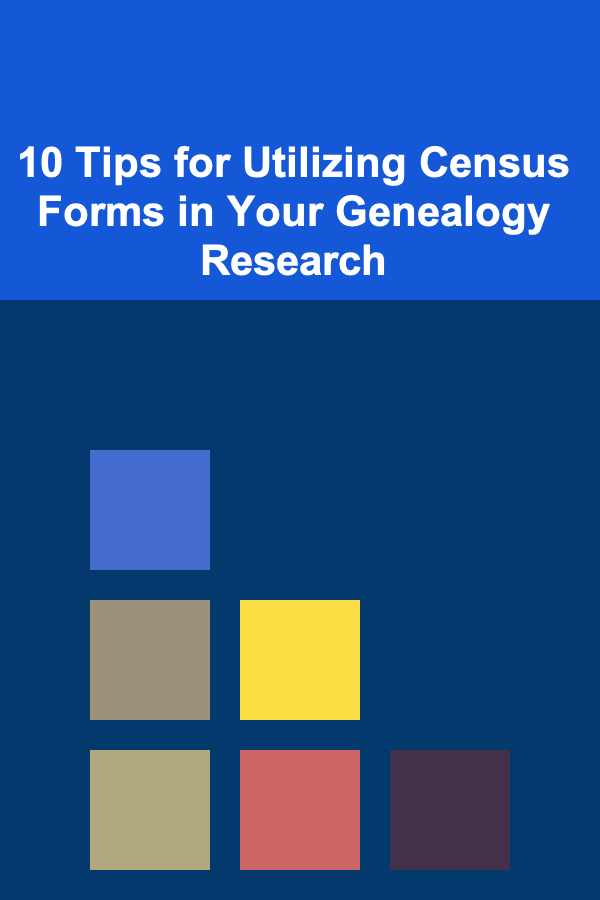
10 Tips for Utilizing Census Forms in Your Genealogy Research
ebook include PDF & Audio bundle (Micro Guide)
$12.99$8.99
Limited Time Offer! Order within the next:

Census forms are invaluable resources for genealogical research, offering a snapshot of your ancestors' lives, communities, and personal details at various points in history. They provide a treasure trove of information that can help trace family lines, understand migration patterns, and gain insights into your ancestors' socio-economic status. In this article, we'll explore ten tips for effectively utilizing census forms in your genealogy research, from understanding their historical context to leveraging the right tools for optimal results.
Understand the Historical Context of Census Records
The first step in using census forms for genealogy research is to understand the historical context in which they were created. Census records are not only a tool for government officials but also reflect the social and political atmosphere of their time. Here are some factors to consider:
- Time Periods: Different decades often reveal varying types of questions. For example, early census records might focus on headcounts, while later ones include more detailed inquiries into family members, occupations, and household structures.
- Regional Variations: Depending on the country or region, the questions and format of census records may vary. Understanding these nuances can help interpret the data more accurately.
- Privacy Laws and Redactions: Some census records, particularly in the United States, may have a 72-year privacy restriction. For instance, the 1950 U.S. Census was released in 2022, and as more records are released, your research can expand.
Understanding these nuances allows you to interpret census data with a clearer perspective and avoid common pitfalls in genealogical research.
Start with the Most Recent Census Available
When beginning your genealogical research, always start with the most recent census record available. The reason for this is that these records are likely to have more complete and accurate data. Later census forms tend to include more detailed questions about:
- Household Members: You can identify immediate family members, their ages, relationships to the head of the household, and places of birth.
- Occupations: Later censuses often ask for the type of work individuals did, offering insights into their socio-economic status and possible migration patterns based on job markets.
- Homeownership: Information about whether a family owned or rented their home, the value of the property, and whether it had a mortgage can give you a clearer picture of their financial situation.
This information can help you piece together a more accurate family history before diving into earlier, less detailed census records.
Pay Close Attention to the Family Structure and Relationships
Census forms often provide insights into family structure that go beyond just names. Many of these forms include fields that identify relationships between individuals in a household. This is crucial for pinpointing family dynamics and tracing family lines.
Key things to look for:
- Head of Household: This is typically the first person listed in a census record, and everyone else is usually categorized in relation to them (e.g., wife, son, daughter).
- Relationships: Later census records specify relationships (e.g., "wife," "mother," "son," "daughter"), which can help confirm family ties and rule out possible errors or ambiguities in the data.
- Marital Status: Information about whether individuals are married, single, divorced, or widowed helps track life stages and family histories.
By paying close attention to these relationships, you can start to build more detailed family trees and ensure that the individuals you are researching are indeed part of your ancestral lineage.
Look for Immigration and Naturalization Information
Census records often include valuable information about immigration and naturalization, particularly for individuals who came from other countries. While not all censuses ask about citizenship status, many do include questions that can help identify your ancestor's immigrant status.
Some helpful clues to look for include:
- Place of Birth: Many census records list the birthplace of each family member, often identifying if they were born in another country.
- Year of Immigration: Some later census forms ask when a person immigrated, helping to place them in a historical context and give a timeline for migration.
- Naturalization Status: Questions regarding whether individuals had become U.S. citizens can help clarify whether an ancestor was an immigrant and when they arrived in the country.
These pieces of information are essential for tracing the paths of immigrant ancestors, especially when other records like ship manifests or naturalization records are unavailable.
Use Census Data to Confirm or Refute Other Records
Census forms are excellent tools for verifying other genealogical records. For instance, they can serve as corroborative evidence for:
- Birth, Marriage, and Death Records: Census records can confirm dates and locations provided by birth certificates, marriage records, or death certificates, or they can help identify inconsistencies that require further investigation.
- Military and Pension Records: Details like age, birthplace, and occupation on a census form can confirm details found in military service records or pension applications.
- Land Records and Wills: Information from census data, such as property ownership or wealth status, can be cross-referenced with land deeds or wills.
By cross-referencing different types of records, you increase the accuracy of your genealogical research and build a more comprehensive family history.
Track Changes in Names and Spelling Variations
It's essential to recognize that names often change across census records due to misspellings, name changes, or even preferences for different forms of a name. Look for different versions of the same name over time.
- Spelling Variations: Names may be spelled differently from one census to the next. This is particularly common for immigrant families whose names were anglicized or altered in the census-taker's transcription.
- Nicknames and Initials: You may find that a person is listed by a nickname, initials, or a shortened version of their given name.
- Marriage Changes: If a woman changes her last name due to marriage, this can be tracked across different census years, especially when searching for maiden names.
Understanding and recognizing these variations is key to identifying the right person in census records, as well as tying together different pieces of your family history.
Investigate Neighbors and the Broader Community
Census forms offer a fascinating window into the communities your ancestors lived in. Pay attention to the neighbors listed next to your ancestors, as these people may have been close family members, friends, or even fellow immigrants from the same area of the world.
Here's what you can discover by studying the broader community:
- Family Connections: Sometimes, multiple families lived near one another due to shared origins, such as being from the same town or region in their country of origin.
- Cultural Groups: You may identify ethnic or religious groups that clustered together in specific neighborhoods, providing insight into your ancestor's cultural background.
- Economic Status: The social class and occupation of neighboring families can shed light on the economic standing of your ancestors, offering clues about why they may have moved or changed occupations.
By broadening your scope and examining the wider community, you can gather additional context about your ancestors' lives.
Take Advantage of Online Databases and Indexes
In today's digital age, most census records are accessible through online databases and genealogical websites. These tools can greatly simplify your search and save time. Websites like Ancestry.com, FamilySearch.org, and MyHeritage host vast collections of indexed census records that allow you to search by name, location, and year.
Benefits of using online tools:
- Searchable Databases: You can quickly search for individuals based on known details like names, birth dates, and locations.
- Transcriptions and Indexes: Many websites provide transcriptions or indexes of census records, making it easier to find your ancestor without manually reviewing each form.
- Hints and Suggestions: Online databases often offer "hints" for records that might be related to your search, which can lead you to more records and information.
Be sure to take advantage of these tools, as they significantly enhance your research capabilities and help streamline the process.
Don't Overlook Enumerations of Other Groups
In addition to general census records, there are sometimes special enumerations for other groups that could be important for genealogical research. For example:
- Slave Schedules (U.S. Census): In the 1850 and 1860 U.S. censuses, slave schedules were separately enumerated, offering valuable information about enslaved individuals, their age, sex, and relationships.
- Institutional Records: Special census enumerations also included individuals living in institutions such as hospitals, prisons, or poorhouses. These records can offer insights into ancestors who may have lived in these facilities.
These specialized records can often provide details that are not found in the general census enumeration.
Document and Organize Your Findings
As you collect census data, it's important to document and organize your findings systematically. Create a research plan and maintain a record of the census forms you've reviewed, the information you've found, and any discrepancies you've encountered. This organization will help you avoid confusion and track your progress as you uncover more details.
Here are some tips for organizing your findings:
- Create a Family Tree: Use genealogical software or a family tree template to visually map out relationships and connections.
- Keep a Research Log: Record the details of each census record you review, noting any new information and the dates you accessed the records.
- Save Copies of the Records: Always save digital or physical copies of the census forms you find, as they may be needed for further reference.
Organizing your research ensures that you don't lose valuable data and helps you stay focused on your genealogical goals.
Conclusion
Census records are a cornerstone of genealogical research. By understanding how to use them effectively, from comprehending historical context to cross-referencing with other records, you can unlock a wealth of information about your ancestors. Each census form offers a unique snapshot of time, providing clues to family relationships, migration patterns, and socio-economic standing. With the right approach, census records can help you piece together a detailed and accurate family history that spans generations.
Reading More From Our Other Websites
- [Organization Tip 101] What Are the Best Ways to Organize Your Home Library?
- [Organization Tip 101] How to Store Art Supplies for Easy Access
- [Personal Financial Planning 101] How to Choose the Best Money Management Apps for Your Unique Needs: A Comprehensive Review & Comparison
- [Home Pet Care 101] How to Winterize Your Pet's Home for Comfort and Safety
- [Mindful Eating Tip 101] How to Blend Mindful Eating with Traditional Ayurvedic Meal Planning
- [Ziplining Tip 101] From Jungle Dawn to Sunset Glide: Capturing the Ultimate Zipline Experience in the Rainforest
- [Weaving Tip 101] Weaving New Paths: Turning Fiber Arts into Unforgettable Adventures
- [Home Soundproofing 101] How to Use Bookshelves for Effective Soundproofing in Your Home
- [Home Budget Decorating 101] How to Decorate Your Home for the Holidays Without Overspending
- [Home Party Planning 101] How to Plan a Successful Home Party with Limited Time and Resources

How to Clean Your Windows Like a Professional
Read More
How to Maintain Your Home's Fireplace and Chimney for Safety
Read More
How to Make Money Online as a Biomedical Engineer? 10 Actionable Ideas
Read More
How to Offer Early Bird Discounts Through Event Registration: A Comprehensive Guide
Read More
How to Refresh Your Living Room with DIY Projects
Read More
How To Compose Powerful Images
Read MoreOther Products

How to Clean Your Windows Like a Professional
Read More
How to Maintain Your Home's Fireplace and Chimney for Safety
Read More
How to Make Money Online as a Biomedical Engineer? 10 Actionable Ideas
Read More
How to Offer Early Bird Discounts Through Event Registration: A Comprehensive Guide
Read More
How to Refresh Your Living Room with DIY Projects
Read More